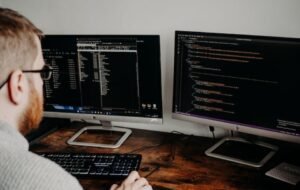Generative Art Definition
Generative art is a unique form of artistic expression that utilizes algorithms, data, and computer software to create art. This innovative approach allows artists to create artwork that is constantly evolving and can result in an infinite number of variations.
Key Takeaways:
- Generative art uses algorithms and computer software to create constantly evolving artwork.
- It is a unique form of artistic expression that explores the intersection of technology and creativity.
- Generative art can result in an infinite number of variations, making each piece of art truly unique.
Generative art is characterized by its use of algorithms and computer programs to generate artwork. These algorithms are designed to produce outputs that exhibit an element of randomness, enabling the creation of unique and unpredictable pieces of art. The use of technology in the creative process allows artists to explore new possibilities and break away from traditional methods of art creation.
One of the fascinating aspects of generative art is the ability to create artwork that evolves over time. The algorithms and data used in generative art often rely on dynamic inputs such as live data feeds, user interactions, or even the passage of time itself. This dynamic nature gives generative art a sense of life and movement, as the artwork can change and adapt based on external factors.
Exploring the Elements of Generative Art
Generative art often incorporates various elements to create visually stunning and thought-provoking pieces. Here are some common elements found in generative art:
- Noise Patterns: The use of random or noisy patterns adds an element of unpredictability to the artwork.
- Fractals: Fractals are repeating geometric patterns that can be found at different scales, creating intricate and complex visuals.
- Particles and Simulations: Simulating natural phenomena, such as fluid dynamics or particle systems, can generate mesmerizing visuals.
Generative art can be seen as a collaboration between the artist and the algorithms they employ. The artist sets the initial parameters and rules, while the algorithms generate the actual artwork based on those inputs. This collaboration between human creativity and computer-generated outputs often leads to surprising and innovative results.
The Impact of Generative Art
Generative art has had a significant impact on the art world and beyond. It challenges traditional notions of authorship and creativity, blurring the lines between human and machine. The accessibility of technology has also made generative art more widespread, allowing artists from a variety of backgrounds to explore this innovative form of expression.
Table 1: Notable Generative Artists and Their Contributions
| Artist | Contribution |
|---|---|
| Vera Molnar | Pioneered the use of algorithms in art, creating geometric and abstract compositions. |
| Aaron Koblin | Known for his data-driven artworks that visualize complex information. |
| Refik Anadol | Uses AI and machine learning to create immersive and interactive installations. |
Generative art has also found applications beyond the art world. It has been used in fields such as architecture, design, and advertising to create visually striking and unique experiences. The ability to generate infinite variations of an artwork using algorithms opens up new possibilities for customization and personalization.
Table 2: Applications of Generative Art
| Field | Application |
|---|---|
| Architecture | Designing complex and innovative structures based on generative algorithms. |
| Design | Creating visually stunning patterns and textures for various products. |
| Advertising | Developing captivating and unique visuals to convey brand messages. |
As generative art continues to evolve, it raises questions about the role of technology in creativity and challenges traditional notions of what art can be. With the potential for infinite variation and the ability to adapt to changing inputs, generative art represents a dynamic and ever-evolving form of artistic expression.
Table 3: Advantages of Generative Art
- Unlimited variations: Each piece of generative art can be unique, offering infinite possibilities.
- Dynamic and ever-evolving: Generative art can adapt and change over time, keeping the viewer engaged.
- Incorporation of technology: It allows for the exploration of the creative potential of algorithms and computer software.
- Blurring of boundaries: Generative art challenges traditional notions of authorship and creativity.
Embrace the Evolution of Art
Generative art truly represents the convergence of technology and creativity. It opens up new horizons for artists and viewers alike, pushing the boundaries of what is possible in the realm of artistic expression. Whether you are an artist, a technology enthusiast, or simply an admirer of art, exploring generative art is an exciting journey that invites you to embrace the evolution of art and the endless possibilities it holds.

Common Misconceptions
Misconception 1: Generative art is the same as computer-generated art
One common misconception about generative art is that it is the same as computer-generated art. While computer-generated art is created using algorithms and software, generative art is a broader concept that encompasses the creation of art through various processes, including using algorithms as well as human intervention and input.
- Generative art involves human creativity and input
- Computer-generated art is a subset of generative art
- Generative art can also be created without the use of computers
Misconception 2: Generative art is simply random or chaotic
Another misconception is that generative art is just random or chaotic. While some generative artworks may appear random at first glance, they are often created based on specific rules or algorithms that guide the generation process. These rules can be defined by the artist to create a desired outcome or aesthetic.
- Generative art can exhibit patterns and structure
- Randomness can be controlled and manipulated in generative art
- Generative art can have intention and purpose behind it
Misconception 3: Generative art is only created by programmers or tech-savvy individuals
Many people believe that generative art can only be created by programmers or tech-savvy individuals. While knowledge of programming and algorithms can be helpful in creating generative art, it is not a requirement. Artists from various backgrounds can explore generative art by using accessible tools and platforms specifically designed for creating generative artworks.
- Artists from different disciplines can create generative art
- There are user-friendly software and tools available for creating generative art
- Collaborations between artists and programmers can result in unique generative art
Misconception 4: Generative art lacks artistic value or skill
Some people may think that generative art lacks artistic value or skill because it is created using algorithms and automation. However, generative art requires creativity, aesthetic sensibility, and mastery of various artistic techniques. Artists who work with generative art often explore new possibilities and push the boundaries of traditional art forms.
- Generative artists need to possess artistic skills and knowledge
- Generative art can be as expressive and meaningful as other art forms
- Artists can use generative art to experiment and explore new artistic concepts
Misconception 5: Generative art is impersonal and lacks human touch
There is a misconception that generative art is impersonal and lacks the human touch that traditional art possesses. However, generative art can evoke personal and emotional responses just like any other form of art. The artist’s decisions, choices, and intentions play a crucial role in shaping the final artwork, even if some aspects are generated through algorithms.
- Generative art can be a deeply personal and introspective form of expression
- The artist’s hand is present in the creative process, even if it involves automated generation
- Generative art can engage and connect with the audience on an emotional level

Generative Art
Generative art refers to the creation of artwork that is produced using a predefined set of rules or algorithms. These rules determine how the artwork will evolve or change over time. Generative art can be created using various mediums, such as computer programs, mathematical equations, or even physical processes. It often explores the relationship between the artist, the artwork, and the audience, as the artwork is continuously evolving and changing. The following tables showcase different aspects and examples of generative art.
Table 1: Artists Using Generative Art
This table highlights some prominent artists who have used generative art to create their artwork. These artists have embraced technology and mathematical algorithms in their creative process, resulting in unique and ever-evolving pieces of art.
| Artist | Artwork |
|---|---|
| Vera Molnar | Random Dots |
| Harold Cohen | AARON |
| Casey Reas | Processing |
| Manfred Mohr | Computer Graphics and Space |
| Alice Aycock | Maze |
Table 2: Generative Art Techniques
This table showcases different techniques and methodologies used in generative art. These techniques help artists express their creativity and produce artwork that goes beyond the limits of traditional art creation.
| Technique | Description |
|---|---|
| Cellular Automata | Artwork created by using a grid of cells that evolve based on specific rules and neighbor interactions. |
| Fractal Geometry | Artwork created using mathematical patterns that repeat infinitely at different scales. |
| Data Visualization | Artwork created by representing complex data sets in visual forms, allowing for new insights and interpretations. |
| Algorithmic Art | Artwork created by employing algorithms or mathematical equations to generate visual patterns and structures. |
| Interactive Art | Artwork that encourages viewer participation and interaction, often responding to user input or environmental stimuli. |
Table 3: Generative Art in Popular Culture
This table explores instances where generative art has made an impact in popular culture, influencing various fields such as music, film, and design.
| Field | Example |
|---|---|
| Music | Brian Eno’s ambient music compositions created using generative systems. |
| Film | The procedural generation of landscapes in the movie ‘Avatar’. |
| Design | Generative design tools used by architects to create innovative building structures. |
| Gaming | The dynamic generation of game environments in the ‘No Man’s Sky’ video game. |
| Fashion | Generatively designed clothing patterns that adapt to individual body types. |
Table 4: Generative Art Examples
This table showcases various examples of generative art, providing a glimpse into the diverse range of artistic expressions produced through the use of algorithms and rules.
| Artwork | Materials |
|---|---|
| Artificial Sunflowers | Digital image generated through cellular automata. |
| Geomorph | 3D printed sculpture created using generative software. |
| Dynamic Patterns | Interactive projection mapping installation responding to user movement. |
| Generative Music Composition | An audio composition generated using algorithmic principles. |
| Emergent Structures | Architectural models generated based on biological growth algorithms. |
Table 5: Benefits of Generative Art
This table outlines the various benefits and advantages of using generative art as a means of artistic expression.
| Benefit | Description |
|---|---|
| Endless Creativity | The ability to generate an infinite number of unique art pieces. |
| Exploration of Complex Concepts | Generative art allows for the visualization and understanding of complex ideas and systems. |
| Adaptive and Evolving Artwork | Art that can change, adapt, and respond to different environments or inputs. |
| Innovation in Traditional Art Forms | Utilizing technology to push the boundaries of traditional art creation techniques and concepts. |
| Interdisciplinary Collaboration | Bringing together artists, programmers, scientists, and other professionals to create unique artworks. |
Table 6: Generative Art Tools and Software
This table showcases popular tools and software used by artists to create generative art, enabling them to transform their ideas into visually captivating artworks.
| Tool/Software | Description |
|---|---|
| Processing | An open-source software platform designed for creating interactive visuals, animations, and more. |
| NodeBox | A data visualization and generative design software that allows for the creation of complex visual art. |
| Houdini | A 3D animation and procedural modeling software with powerful tools for generative artwork creation. |
| Cinder | A C++ framework used for the development of creative applications, including generative art projects. |
| Generative Design | An Autodesk software that applies artificial intelligence and algorithms to create generative design solutions. |
Table 7: Generative Art vs. Traditional Art
This table presents a comparison between generative art and traditional art, highlighting the unique characteristics and qualities of each form of artistic expression.
| Aspect | Generative Art | Traditional Art |
|---|---|---|
| Authorship | Shared between the artist and the generative system. | Primarily attributed to the artist alone. |
| Originality | Endless variations and possibilities, promoting a sense of uniqueness. | Often focuses on creating one-of-a-kind, singular pieces. |
| Process | Code-driven process, with the artist designing rules for the artwork’s creation. | Manual artistic creation, involving various techniques and mediums. |
| Change over Time | Artwork can evolve, adapt, and respond to different environments and stimuli. | Fixed and static, capturing a particular moment or composition. |
| Engagement | Encourages viewers to engage, explore, and interact with the artwork. | Passive observation and interpretation of the artwork. |
Table 8: Influential Books on Generative Art
This table provides a curated list of books that delve into the theory, practice, and history of generative art.
| Book Title | Author |
|---|---|
| Generative Design | Hartmut Bohnacker, Benedikt Groß, Julia Laub, and Claudius Lazzeroni |
| Form+Code in Design, Art, and Architecture | Casey Reas, Chandler McWilliams, and LUST |
| The Nature of Code | Daniel Shiffman |
| Emergence: The Connected Lives of Ants, Brains, Cities, and Software | Steven Johnson |
| The Algorithmic Beauty of Plants | Przemyslaw Prusinkiewicz and Aristid Lindenmayer |
Table 9: Exhibition Showcase of Generative Art
This table highlights some notable exhibitions across the world that have focused on showcasing generative art and the artists behind these dynamic artworks.
| Exhibition Name | Location |
|---|---|
| GRAMMATRON | New York City, USA |
| Tomorrow Never Knows | London, UK |
| ArtFutura | Barcelona, Spain |
| Generative Art International Exhibition | Ravenna, Italy |
| Onedotzero Festival | Lisbon, Portugal |
Table 10: Impact of Generative Art on Science and Technology
This table explores the influence of generative art on scientific research and technological advancements, showcasing the interdisciplinary nature of this innovative art form.
| Field | Impact |
|---|---|
| Artificial Intelligence | Generative art techniques have fueled advancements in machine learning and pattern recognition algorithms. |
| Complex Systems | Generative art has helped researchers visualize and understand the behavior of complex systems, such as biological and social networks. |
| Data Analysis | Artistic methods and visualization techniques derived from generative art have facilitated data analysis and insights in various fields. |
| Simulation | Generative art has provided new tools and approaches for simulating and exploring physical phenomena and scientific theories. |
| Human-Computer Interaction | The interactive nature of generative art has informed the development of novel user interfaces and interaction paradigms. |
In conclusion, generative art blends artistic creativity with computer algorithms and mathematical principles to produce constantly evolving and unique works of art. From prominent artists embracing generative art techniques to its influence in popular culture and interdisciplinary fields, this art form continues to push the boundaries of traditional art creation and engage viewers in new and innovative ways. Through the use of generative art, artists have harnessed the power of technology to create endlessly diverse and captivating works that challenge our perception of art and its relationship with the audience.




